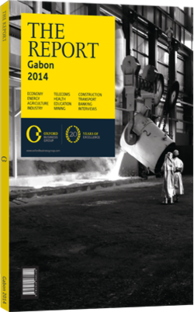Upgrades at ports can improve logistics performance
Authorities in Gabon have acknowledged the problems facing transport infrastructure, and international pressure is leading to local action. The country’s results in the World Economic Forum’s 2013-14 “Global Competitiveness Report” were disappointing, with Gabon taking 133rd place out of 149 countries, on a score of 2.7 out of 7. The minister of transport, Paulette Mengué M’Owono, told a conference organised by the Bureau of Ports and Harbours of Gabon (Office des Ports et Rades du Gabon, OPRAG) in April that the country’s infrastructure “deficit” had become “chronic” and was damaging both the competitiveness of Gabonese products while increasing the cost of living, a sensitive political issue. At the conference, OPRAG’s director-general, Rigobert Ikambouayat-Ndeka, said that since 2009 there had been a consensus that port infrastructure was insufficient, citing factors such as shallow access channels and draughts and comparatively short quay lengths at the two main ports in Libreville and Port-Gentil.
Port Congestion
As a result of constraints, industry figures say current infrastructure at Owendo struggles to meet demand. “Congestion at Owendo is due to the quays only being able to receive two ships simultaneously as well as growth in port traffic, including bulk cargo ships transporting construction materials and equipment for the various projects under way in Gabon,” Bertrand Rose, CEO of Necotrans Gabon told OBG. Cost is also an issue; companies complain that long turnarounds in port drive up expenses, in particular given a policy in place of charging ship-owners by the day rather than a fixed fee.
However, here too efforts are under way to boost infrastructure and improve capacity. February 2013 saw the beginning of work to build a new 500-metre quay at Owendo, and 70 metres across, with a draught of up to 13 metres. The project is being undertaken by the UAE-based Divers Marine Contracting on behalf of Société de Développement des Ports, an affiliate of the Gabonese Fund for Strategic Investment, at a cost of $62m. It is scheduled to take two years to complete. One side of the wharf will be dedicated to container ships while the other will receive bulk cargo ships and ro-ro vessels. In the second phase a container terminal will be constructed for the quay. OPRAG also plans to extend the existing main quay at Owendo in coming years by at least 200 metres, though as yet there is no precise timetable for this.
Owendo has also seen significant investment in handling equipment in recent years; in September 2013, Gabon Port Management took delivery of a new CFA3bn (€4.2m) crane for the port, which the firm said would speed up operations. The move followed its previous acquisition of two cranes in March 2012 and should further significantly boost efficiency at the port, though other challenges remain. “The container terminal is capable of receiving much greater numbers of terminals than previously as the storage space has been expanded, and there have been significant investments in handling equipment,” said Rose. “Congestion in the port is not a problem at the terminal itself, but rather at the final point of unloading, where storage space is often lacking.”
All In One
In another move to boost efficiency at the country’s ports, in April 2014 the government said that OPRAG would open a one-stop shop (guichet unique) under the prime ministry and the Ministry of Transport at the country’s ports to handle administrative procedures for ship owners, in order to reduce red tape and speed up imports and exports; the move has been mooted for several years. The project will involve computerising many administrative and Customs procedures currently carried out by hand. Such reforms should reduce waiting times and costs. “Inadequate infrastructure and a lack of storage space make stocking containers at Owendo expensive,” said Rose. However, the implementation of the guichet unique for imports and exports will make the process more efficient. “Time consumes money in logistics, so faster processes create greater gains in cost savings.”
You have reached the limit of premium articles you can view for free.
Choose from the options below to purchase print or digital editions of our Reports. You can also purchase a website subscription giving you unlimited access to all of our Reports online for 12 months.
If you have already purchased this Report or have a website subscription, please login to continue.

